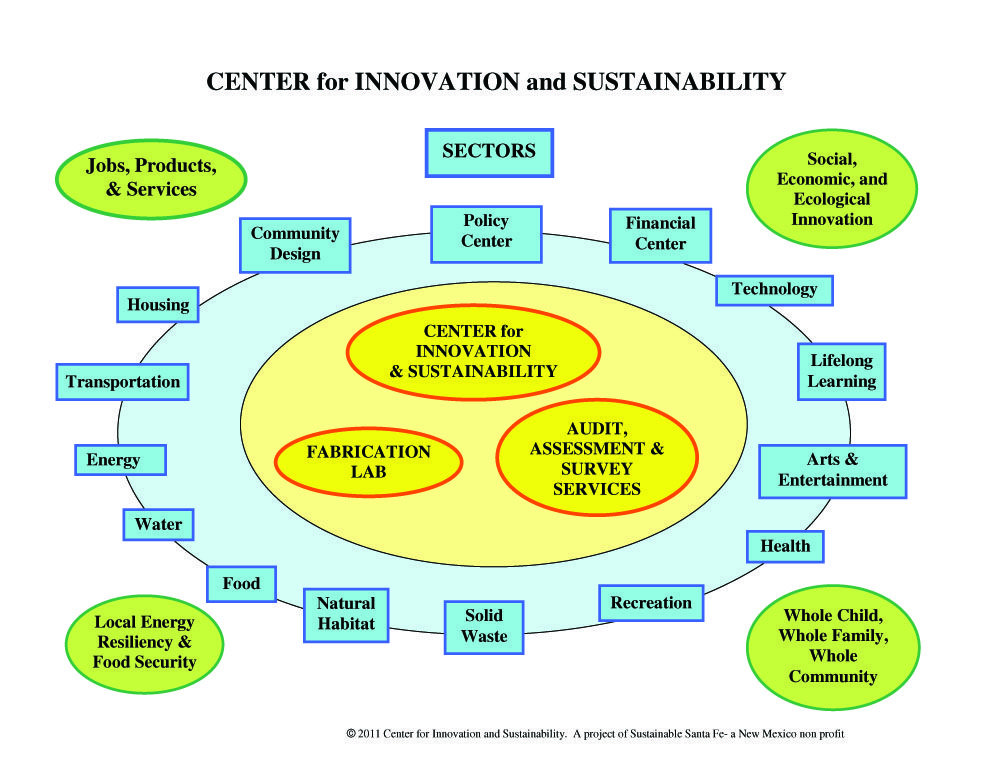By Brian, on May 6th, 2012
Last September I got to be the guest associate editor of Green Fire Times. The entire issue was dedicated to envisioning the creation of “Sustainable Urban Villages” in our area – vibrant, alive, quality-filled, deeply affordable, mixed-use, mixed-income neighborhoods that live lightly on the planet. The challenge remains: How do we actually create sustainable “triple bottom line” alternatives to suburban sprawl – thriving, resilient communities that are good for people, the planet and the polar bears?
If done right, a smart infill demonstration Sustainable Urban Village (SUV) showcase in Santa Fe would generate local economic development, expand ecotourism and help transform the planet. In today’s hyperlinked world, solving problems anywhere solves problems everywhere. So Santa Fe, let’s get it done!
The Puzzle of 1000 Pieces
Santa Fe and northern New Mexico has a lot of talented innovators, creative thinkers and pioneers. As the accompanying illustration shows, there are many pieces (see blue sectors) that need to be integrated to achieve sustainability. How can we put the puzzle together so that we create win-win-win solutions? I contend we need 1) an accessible, supportive, collaborative environment for innovation; and 2) smart 3D modeling tools.

Center for Innovation and Sustainability
I’m proposing a Center for Innovation and Sustainability (CIS), an ongoing Think and Do Tank facility to harness our genius, wisdom and caring to create local market-driven sustainable products and services. With deep collaboration we can create living examples of desirable neighborhoods where less is more – where lowered consumption from a systems-integrated-design approach creates a higher quality of life and affordable lifestyles. We can design scenarios that use less energy, generate little waste and take into account the less visible impacts of the choices we make on habitats and our ways of life.
Unmet Needs Point to the Emerging Sustainable Economy
Nine thousand employees are currently commuting 2 to 2 1/2 hours daily to and from jobs in Santa Fe. Even though we have an oversupply of suburban sprawl nationwide, various surveys point to significant unmet market demand for simpler, walkable lifestyles. One third of the Baby Boomers want to be living in mixed-use, walkable neighborhoods, and 77% of their children, the Millennials, want to live in creative, lively, urban environments.
Gathering Information, Best Practices, Innovation, and Modeling Tools
So how can the Center for Innovation and Sustainability best work with these demographics and tap into this widespread unmet demand to create attractive, sustainable neighborhoods? I think that an essential part of our approach must be to conduct a more detailed survey and involve these people/customers as planning partners. The CIS could provide audit and assessment services to local institutions, businesses, neighborhoods, nonprofits, schools and families to gather information on existing conditions such as energy usage and waste, and record what people would like to see improved and created.
The CIS could then offer viable options based on best practices and emerging technologies to come up with sustainable products and solutions that address peoples’ needs, such as length of commutes, affordability, health, advanced training and professional development, etc.
With the rapid evolution of technology, the complexity required for the deep integration of systems and the necessity for innovative financial and policy mechanisms, we need high-functioning modeling tools. Smart 3D modeling will allow us to test-drive scenarios to ensure triple bottom line outcomes: social, economic and ecologically beneficial solutions.
When residential densities in a mixed-use neighborhood become high enough to make commercial businesses successful, car-free households become viable options and life becomes more affordable. With neighbors out-and-about walking and biking to their daily tasks, the neighborhood gets a simpler lifestyle with vibrant, alive, child-friendly streets. By integrating the community design with smart grids of renewable energy, cogeneration and district heating and cooling systems, even greater levels of affordability and resiliency are achieved. By adding in a variety of shared amenities and facilities such as parks, plazas and conveniently located lifelong learning opportunities, construction and maintenance costs are lowered and the quality of life increases.
Network of Key Influencers
To achieve this interdisciplinary capability, we are using the “Network of Key Influencers” process practiced by Susan Davis since the 1970s. Susan begins by gathering peer recommendations so the Center’s board will be made up of a talented team from a wide range of sectors, balanced by age, gender, race and geography. Nominees are chosen for their integrity and innovations, their ability to collaborate, high credibility in their field, their innate spiritual connection and willingness to serve the highest good for all, and their passion for the network’s mission; in this case, creating thriving, vibrant, alive, mixed-use, mixed-income sustainable neighborhoods that are “good for people, good for the planet, and good for the polar bears.” Once a list of “Key Influencers” is established, nominees will be invited to a Founder’s Retreat, and a dynamic community support system will be initiated. Together we can build a legacy for future generations.
Is this the kind of community capacity building process you’d love to participate in? If so, please join in! Here are some things you can do:
- Add your ideas of projects you’d like the CIS to take on.
- What kinds of equipment would you use in a Fab Lab? Next month I’ll talk about possibilities.
- Contribute the best practices and ideas that inspire you, and then ask your friends to comment.
- Email or call me if you’d like to become a sector online forum moderator or recommend a Key Influencer 505-310-1797 or go to contacts and email me!
The Center for Innovation and Sustainability is a project of Sustainable Santa Fe, a New Mexico non-profit. The New Mexico Community Foundation is the project’s fiscal sponsor.